Related Research Articles

Karl Eberhard Schöngarth was a German lawyer and SS-Brigadeführer in Nazi Germany. He was a war criminal who perpetrated mass murder and genocide in German-occupied Poland during the Holocaust. He participated in the January 1942 Wannsee Conference, at which the genocidal Final Solution to the Jewish Question was originally planned. After the war, Schöngarth and six others were tried for murdering an American pilot, Americo S. Galle, who was shot down over the Netherlands in November 1944. They were all found guilty. Schöngarth and four others were sentenced to death and executed in 1946.

Einsatzgruppen were Schutzstaffel (SS) paramilitary death squads of Nazi Germany that were responsible for mass murder, primarily by shooting, during World War II (1939–1945) in German-occupied Europe. The Einsatzgruppen had an integral role in the implementation of the so-called "Final Solution to the Jewish question" in territories conquered by Nazi Germany, and were involved in the murder of much of the intelligentsia and cultural elite of Poland, including members of the Catholic priesthood. Almost all of the people they murdered were civilians, beginning with the intelligentsia and swiftly progressing to Soviet political commissars, Jews, and Romani people, as well as actual or alleged partisans throughout Eastern Europe.

Arthur Nebe was a German SS functionary who held key positions in the security and police apparatus of Nazi Germany and was, from 1941, a major perpetrator of the Holocaust.
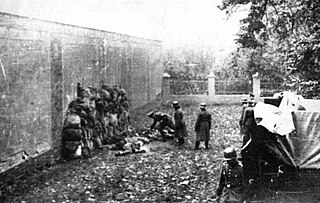
During World War II, the Nazi German Einsatzkommandos were a sub-group of the Einsatzgruppen – up to 3,000 men total – usually composed of 500–1,000 functionaries of the SS and Gestapo, whose mission was to exterminate Jews, Polish intellectuals, Romani, and communists in the captured territories often far behind the advancing German front. Einsatzkommandos, along with Sonderkommandos, were responsible for the systematic murder of Jews during the aftermath of Operation Barbarossa, the invasion of the Soviet Union. After the war, several commanders were tried in the Einsatzgruppen trial, convicted, and executed.
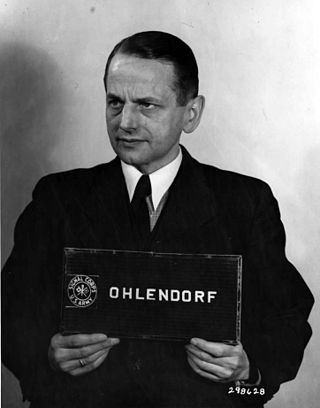
Otto Ohlendorf was a German SS functionary and Holocaust perpetrator during the Nazi era. An economist by education, he was head of the Sicherheitsdienst (SD) Inland, responsible for intelligence and security within Germany. In 1941, Ohlendorf was appointed the commander of Einsatzgruppe D, which perpetrated mass murder in Moldova, south Ukraine, the Crimea and, during 1942, the North Caucasus. He was tried at the Einsatzgruppen Trial, sentenced to death, and executed by hanging in 1951.
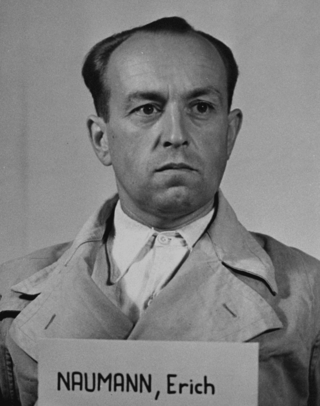
Erich Naumann was an SS-Brigadeführer, member of the SD, and a convicted war criminal. Naumann had a key role in the Holocaust in Eastern Europe as the commander of Einsatzgruppe VI and the commander of Einsatzgruppe B.
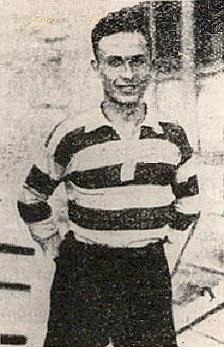
Alexandre Villaplane was a French football player who played as a midfielder. He appeared in the France national team in the 1928 Summer Olympics and captained the national team at the 1930 FIFA World Cup.
Helmut Oberlander was a naturalized Canadian citizen who was a member of the Einsatzgruppen death squads of Nazi Germany in the occupied Soviet Union during World War II. Oberlander was on the Simon Wiesenthal Center's list of most wanted Nazi war criminals. Beginning in 1994, the Government of Canada made several attempts to revoke Oberlander's citizenship on the basis of his misrepresenting his involvement with Nazi war crimes.

Martin Sandberger was a German SS functionary during the Nazi era and a convicted Holocaust perpetrator. He commanded Sonderkommando 1a of Einsatzgruppe A, as well as the Sicherheitspolizei and SD at the time of Nazi German occupation of Estonia during World War II. Sandberger perpetrated mass murder of the Jews in German-occupied Latvia and Estonia. He was also responsible for the arrest of Jews in Italy, and their deportation to Auschwitz concentration camp. Sandberger was the second-highest official of the Einsatzgruppe A to be tried and convicted. He was also the last-surviving defendant from the Nuremberg Military Tribunals.
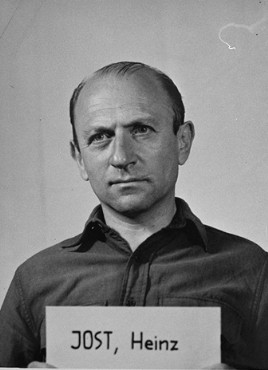
Heinz Jost was a German SS functionary during the Nazi era. He was involved in espionage matters as the Sicherheitsdienst or (SD) section chief of office VI of the Reich Security Main Office. Jost was responsible for genocide in eastern Europe as commander of Einsatzgruppe A from March–September 1942.
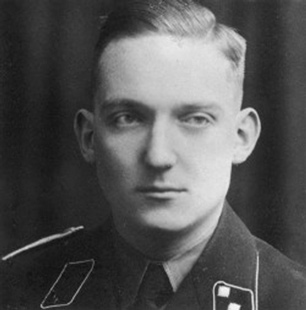
Hermann Schaper, was a German SS functionary during the Nazi era. He was a Holocaust perpetrator responsible for atrocities committed by the Einsatzgruppen in German-occupied Poland and the Soviet Union and was convicted after the war of numerous war crimes.

Karl Rudolf Werner Braune was a German SS functionary during the Nazi era and a Holocaust perpetrator. During the German invasion of the Soviet Union of 1941, Braune was the commander of Einsatzkommando 11b, part of Einsatzgruppe D. Braune organized and conducted mass murders of Jews in the Army Group South Rear Area, the Reichskommissariat Ukraine. For his role in these crimes, Braune was tried before an American military court in 1948 in the Einsatzgruppen trial. He was convicted, sentenced to death and executed in 1951.

Ludwig Hermann Karl Hahn was a German SS-Standartenführer, Nazi official and convicted war criminal. He held numerous positions with the German police and security services over the course of his career with the Schutzstaffel (SS).

ObersturmbannführerBruno Müller or Brunon Müller-Altenau served as an SS Lieutenant Colonel during the Nazi German invasion of Poland. In September 1939, he was put in charge of the Einsatzkommando EK 2, attached to Einsatzgruppe EG I (pl) of the Security Police. They were deployed in Poland along with the 14th Army of the Wehrmacht.
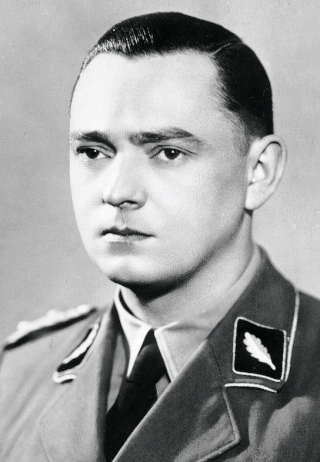
Horst Böhme was a German SS functionary during the Nazi era. He served in the SD, the intelligence service of the SS, and was a leading perpetrator of the Holocaust.
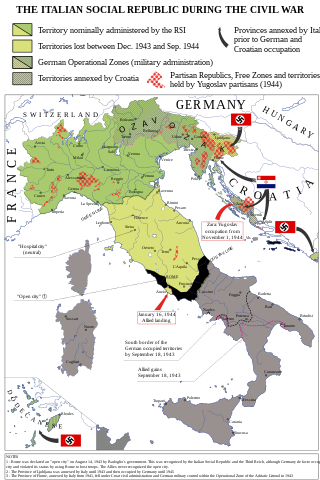
Two of the three major Axis powers of World War II—Nazi Germany and their Fascist Italian allies—committed war crimes in the Kingdom of Italy.
Einsatzgruppe H was one of the Einsatzgruppen, the paramilitary death squads of Nazi Germany. A special task force of more than 700 soldiers, it was created at the end of August 1944 to deport or murder the remaining Jews in Slovakia following the German suppression of the Slovak National Uprising. During its seven-month existence, Einsatzgruppe H collaborated closely with the Hlinka Guard Emergency Divisions and arrested 18,937 people, of whom at least 2,257 were murdered; thousands of others were deported to Nazi concentration camps. The victims included Jews, Romani people, actual or suspected Slovak partisans, and real or perceived political opponents. One of its component units, Einsatzkommando 14, committed the two of the largest massacres in the history of Slovakia, at Kremnička and Nemecká.
References
- ↑ "Germany targets remaining members of Nazi death squads blamed for killing 1 million". NBC news. Associated Press. June 6, 2018. Retrieved May 16, 2021.
- ↑ Zuroff, Dr. Efraim (December 2018). "Worldwide Investigation and Prosecution of Nazi War Criminals: An Annual Status Report (April 1, 2017– March 31, 2018)" (PDF). operationlastchance.org. Simon Wiesenthal Center – Israel Office: Snider Social Action Institute. Retrieved 2019-03-11.
- ↑ Dewert, Damai (22 November 2020). "No trial of suspected Nazi criminals: SS soldier allegedly involved in horrible massacres (Translation)". Hessische/Niedersächsische Allgemeine (in German). Archived from the original on 22 November 2020. Retrieved 22 November 2020.
- ↑ "Gerechtigkeit verjährt nicht: Protestkundgebung zum Geburtstag von SS-Mann Herbert W. in Melsungen". Hessische/Niedersächsische Allgemeine (in German). 10 December 2021. Retrieved 17 December 2021.
- ↑ Hyde, Rob (December 24, 2021). "SS death squad veteran must be put on trial, demand protestors at 100th birthday". The Jewish Chronicle.